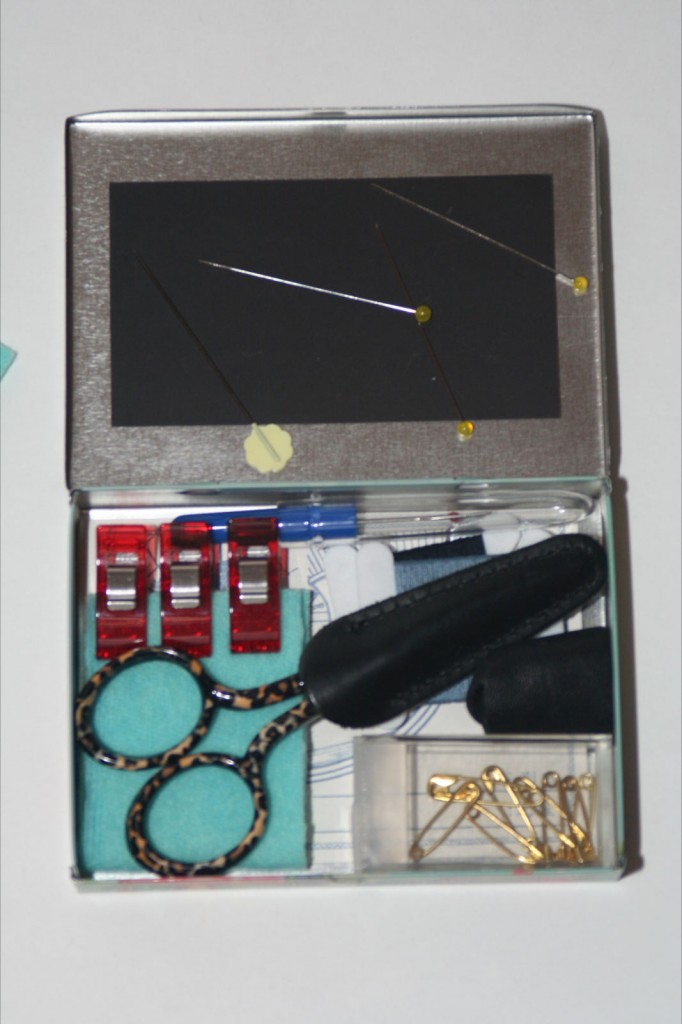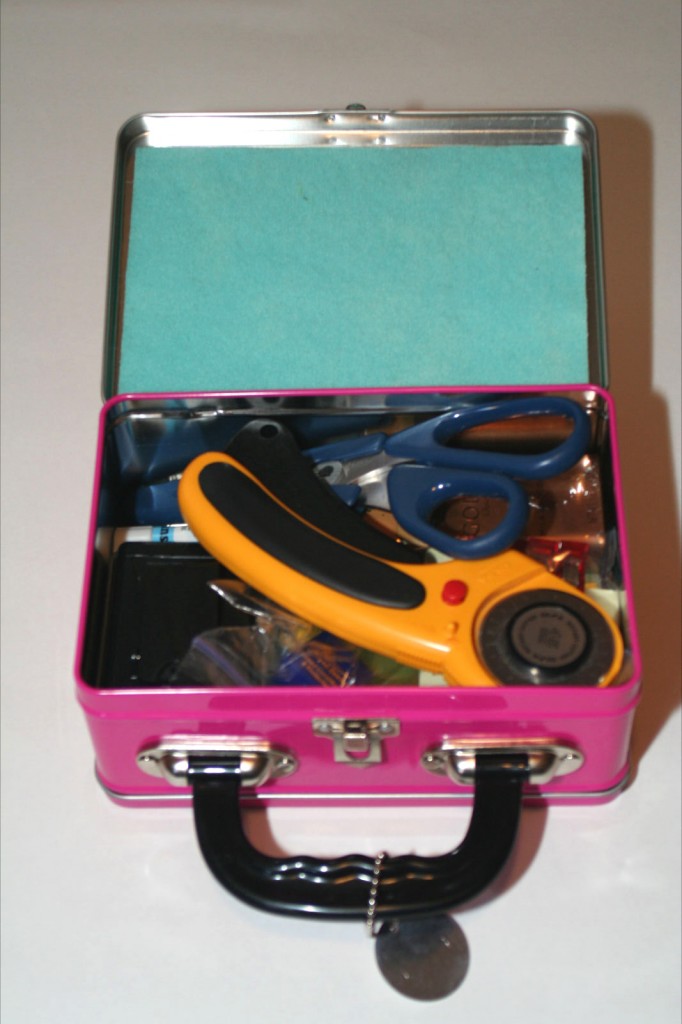 Some of us can’t bear to be parted from our stitching, even on the road. After all, for many of us a perfect vacation starts with a quilt retreat and ends with classes taught by our fave quilt celebs. And if we throw in a couple stops along the way at some awesome quilt shops, chocolate factories and wineries, well then, pack us up now because we are so outta here.
Some of us can’t bear to be parted from our stitching, even on the road. After all, for many of us a perfect vacation starts with a quilt retreat and ends with classes taught by our fave quilt celebs. And if we throw in a couple stops along the way at some awesome quilt shops, chocolate factories and wineries, well then, pack us up now because we are so outta here.
The post-9/11 reality, though, is we are not always safe from evil, even on domestic travels. And while it might seem that the Transportation Security Administration (TSA) changes its restrictions daily for what we’re allowed to bring on a plane—whether carried on or checked—there actually have been very few changes since the 2001 Shoe Bomber was caught trying to ignite his foot odor just three months after the attacks on the World Trade Center and the Pentagon. (The TSA last adjusted the rules about carry-on liquids in 2006 and our beauty routine on the road hasn’t been the same since!)
So, exactly what can you bring with you on a U.S. plane (and what might end up in that sad little pile of discarded items in the airport security area)? We’ve got your back, Q-bies, with all the latest info. Plus, we’ve got a fun project: an adorable little travel sewing kit to hold your most needed tools, along with instructions for adapting your own kit for your specific needs.
Air Travel
Yes, you ARE allowed to bring scissors. (We know…It seems to make no sense because we quilty types know just how much damage we can do to ourselves with those gleaming blades.) Those TSA rule-makers must be quilters (or related to quilters) because the rules are actually very quilt-friendly.
You can carry scissors with rounded tips (like a child’s pair of scissors) or pointed tips that have blades shorter than 4”. That means that your treasured embroidery snips are a go, as are your funky applique scissors and any other small pair.
Contrary to what one reader’s husband told her, all needles are also allowed on board (sewing, knitting, etc…). You can stitch in peace as you sail the blue skies.
 Seam rippers are generally allowed, but again, don’t bring any special ones in case some over-zealous TSA-er confiscates them. (Leave the scalpel-like ones home, and maybe get a less intimidating one for travel. It’ll fit better in your travel case anyway.)
Seam rippers are generally allowed, but again, don’t bring any special ones in case some over-zealous TSA-er confiscates them. (Leave the scalpel-like ones home, and maybe get a less intimidating one for travel. It’ll fit better in your travel case anyway.)
Now, what about sewing machines? Well, if the machine is packed into a carry-on sized box, and you’re under your allotted number of carry-ons, you should be fine bringing it. We know some quilters who wrap batting around their machines, even if they’re using a custom carrying case, to prevent any moving around in the box. Sounds like a good plan to us. If you’re sending your machine as a checked box, wrap it like it’s a newborn. It’s not going to be handled with the awe and respect it deserves, so you want as much padding as possible in and around the machine.
When you check it, ask that it be marked with “fragile” stickers. The attendant might ask you to sign a waiver—and you can decide to do that or not–but if having the machine with you is that important, take the time to really insulate it from damage. You’ll score bonus points (and more peace of mind) if you have the original packing box. And if you have the Styrofoam inserts, well, honey, you get an A+. If you don’t have any of this hard-knocks protection, call your local dealer and see if they have a box you can use.
Now, we haven’t said anything about rotary cutters. That’s because the TSA specifically restricts both box cutters (remember the 9/11 hijackers?) and razor-type blades (not disposable razors…you can still shave those legs) from carry-on bags. We believe that rotary cutters are similar enough, and dangerous enough, to be counted in either category. Pack rotary cutters, as big as you want, along with ice picks, cleavers, sabers and swords (hey, we’re just reading the TSA list) in your checked luggage, so let the slicing begin poolside, we say. Besides, the last thing you want to be doing when you hit turbulence 30,000 miles up is rotary cutting. Trust us on this.
Here’s the bottom line, though: A concerned TSA agent has the absolute right to confiscate anything questionable, so we always follow some common sense rules:
- Carry a print out of the latest TSA restrictions just in case an agent forgets.
- Cross-reference the restricted items list with the airline you’re traveling on. Your specific airline might have conflicting information. Always follow the more restrictive guidelines.
- Don’t bring any heirloom scissors or anything you’re not willing to part with, in case you have a nervous agent hounding you.
- Don’t bring metal knitting needles. While there are no printed restrictions on this, I’d be nervous if I saw you knitting with one of those 14” pointed thingies sitting next to me on a plane. There are plenty of other options, like plastic and bamboo, for making your kiddo’s socks.
- Don’t bury your sewing supplies deep in your carry on bag. There’s a good chance you might have to show them to an agent, and fumbling and digging is aggravating to you and your fellow passengers.
Here’s a short list of basics for your travel sewing kit. Of course, specific types of projects might call for additional items, so freely add to this as needed:
- Small spools of light, medium and dark neutral colored threads for piecing (ivory, tan and gray make great choices)
- Small pair of sharp embroidery scissors
- A selection of hand sewing needles, including sharps, milliners and beading types
- Thread conditioner
- Needle threader
- Folding reading glasses (in case you forget yours)
- Emery board (for broken nails)
- About 20 long pins
- A small pin cushion or mounted magnet for holding pins and needles
- A piece of felt to hold needles and pins that can be folded and tucked into kit
- Small tape measure
- 6” ruler, preferably with clear markings for ¼” seams
- Seam ripper
- Fabric glue stick
- About 4-5 safety pins
- Marking pencils/pens for light and dark fabrics
- A reader’s lamp that hangs from your neck
Some types of projects that are well-suited for travel include:
- Hand applique
- English paper piecing
- Embroidery
- Hand quilting of smaller quilts
- Embellishing
- Cross stitch
- Hand piecing
And here are some tips for getting a road project together:
- Precut all pieces needing rotary cutting.
- Bring a COPY of any instructions or templates, just in case you lose them.
- Have several large, medium and small Ziploc bags with you and a permanent marker to sort and hold pieces, supplies and your project.
- If you’re bringing your sewing machine, be sure to have your manual and accessories with you. Nothing is more frustrating that realizing you’ve forgotten your ¼” foot at home.
- Check your accessory box for any items that might not be allowed on the plane.
- Prewind enough bobbins and bring enough thread.
- Aerosols of any kind (except for very small carry-on toiletries) are not allowed either checked or carried on. This would include spray baste and starch.
- There are some excellent travel irons on the market, but if you’re staying at a hotel, call ahead and ask if they provide irons and boards. Might save one more thing to carry.
- Bring a select group of rotary rulers and a medium sized mat if you think it they will be needed, but make sure they can be comfortably packed in your checked bag.
- Items you might not normally need, but which often come in handy, are a small roll of freezer paper, fusible webbing like Steam-a-Seam Lite, an applique presser sheet and a sketchpad.
Click here to download a nifty travel sewing kit project that’s perfect for planes, trains, and automobiles. And possibly motorcycles, but we still have to test that out.







COMMENT #1
It would be good if you could mark that this advice is for the US – remember you have readers around the world whose countries have their own restrictions…
COMMENT #
Done Katy. Thanks for the thought. For those of us still waiting for stamps in our passport (hubby just won’t get the hint) we sometimes forget that we are not an island unto ourselves on this little planet.
COMMENT #2
Thanks so much for the great article. I’m a Canadian who will be travelling to Germany in May and wanted to continue my hexie vortex. I had checked the KLM website and was thrilled to see that scissors 4″ or less were allowed! DH is not impressed. 😀
COMMENT #
Ah, we’ll have to put DH through the Quilt Husband Retraining Program won’t we? Can we see the Hexie Vortex when it’s done or along the way even? The name alone has me giving it BIG points towards our Quilt of the Week!
COMMENT #3
Excellent post, thanks for that! It seems like there is so much conflicting info on scissors – but I think you said it: much depends on the actual security agent you get at the airport. I’ve been cutting thread and perle cotton with the small blade on the top of a dental floss box! The box is great for holding my snipped threads, too.
COMMENT #4
I had 4″ scissors taken away from me in Zurich a few years back, after being OK with them thru LAX, DC, France and Italy. I second taking a pair that you don’t care so much about, and also checking the local country’s regulations.
COMMENT #5
Thanks for all the info! I’ve been afraid to carry anything with me to sew.
COMMENT #6
Three years ago, running late for a SW flight out of Midway (Chicago), I determined it was more important to get to the plane and possibly loose my 45mm Rotary cutter to a TSA agent than check the bag and have to take a later flight. There was quilting that needed to be done on the other side! Must quilt. Anyway, surprisingly I breezed through TSA going and coming. It both amazing and surprised me, b/c we all know they are a lot more dangerous than a box cutter.
COMMENT #7
What an excellent post!